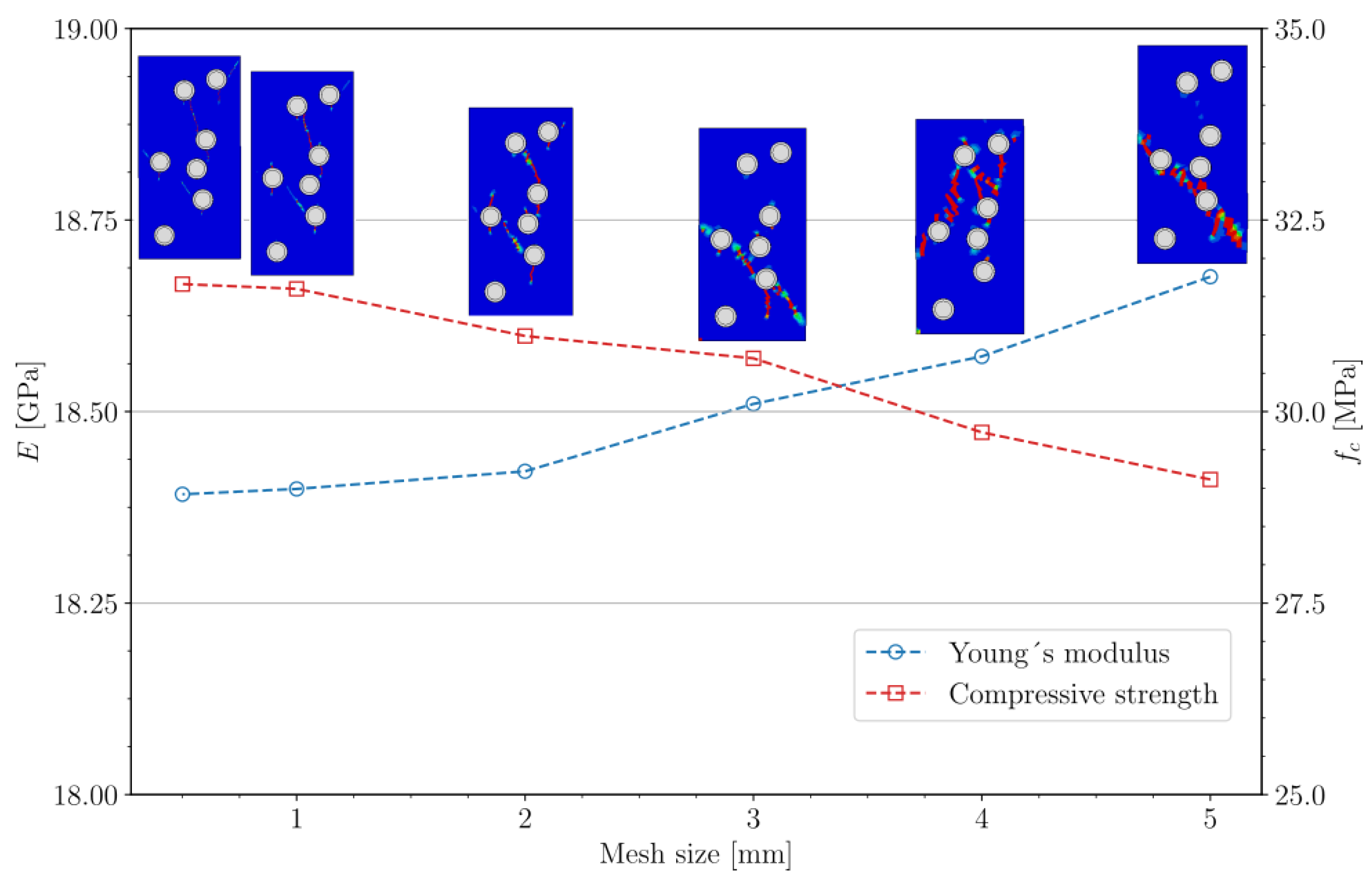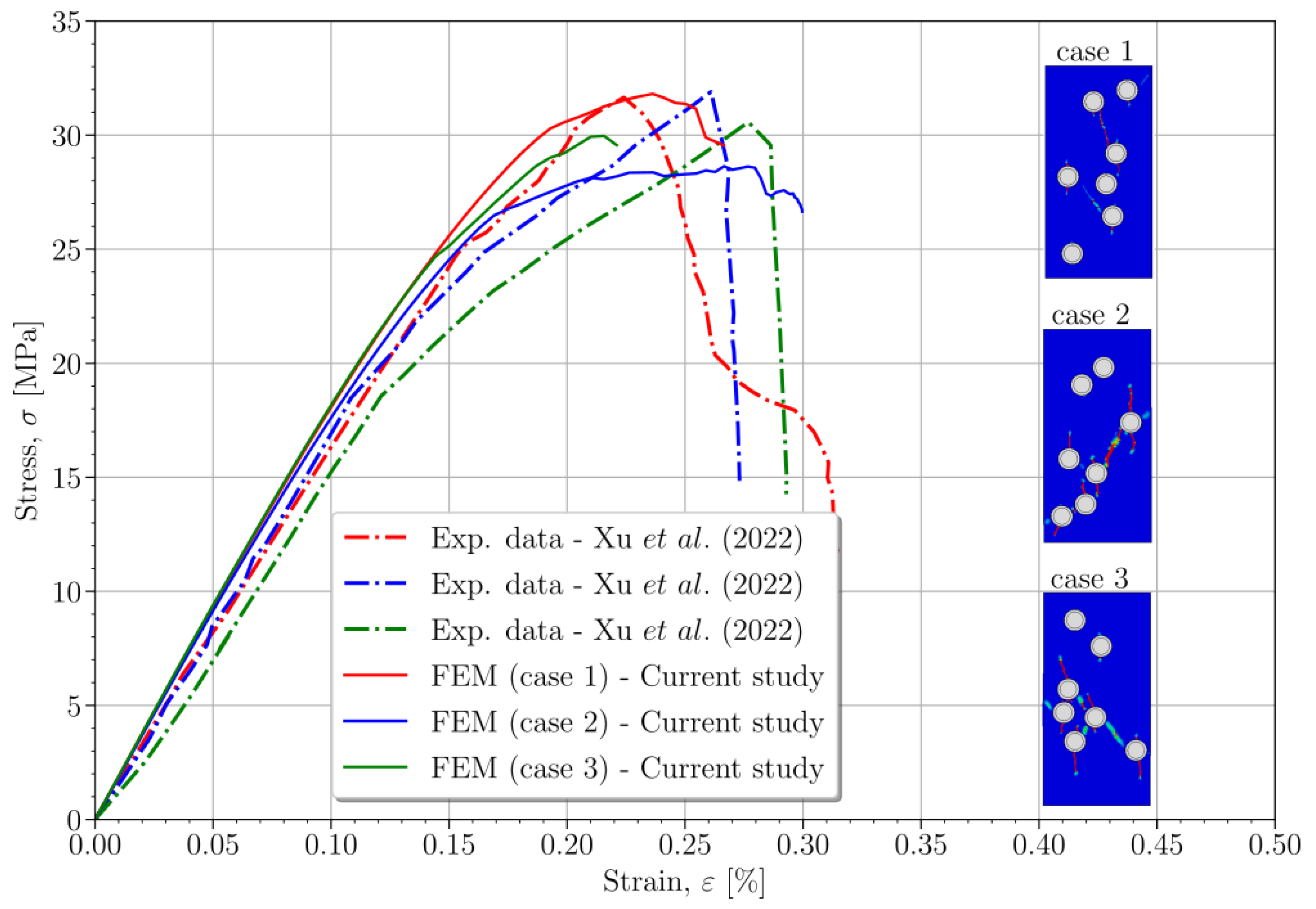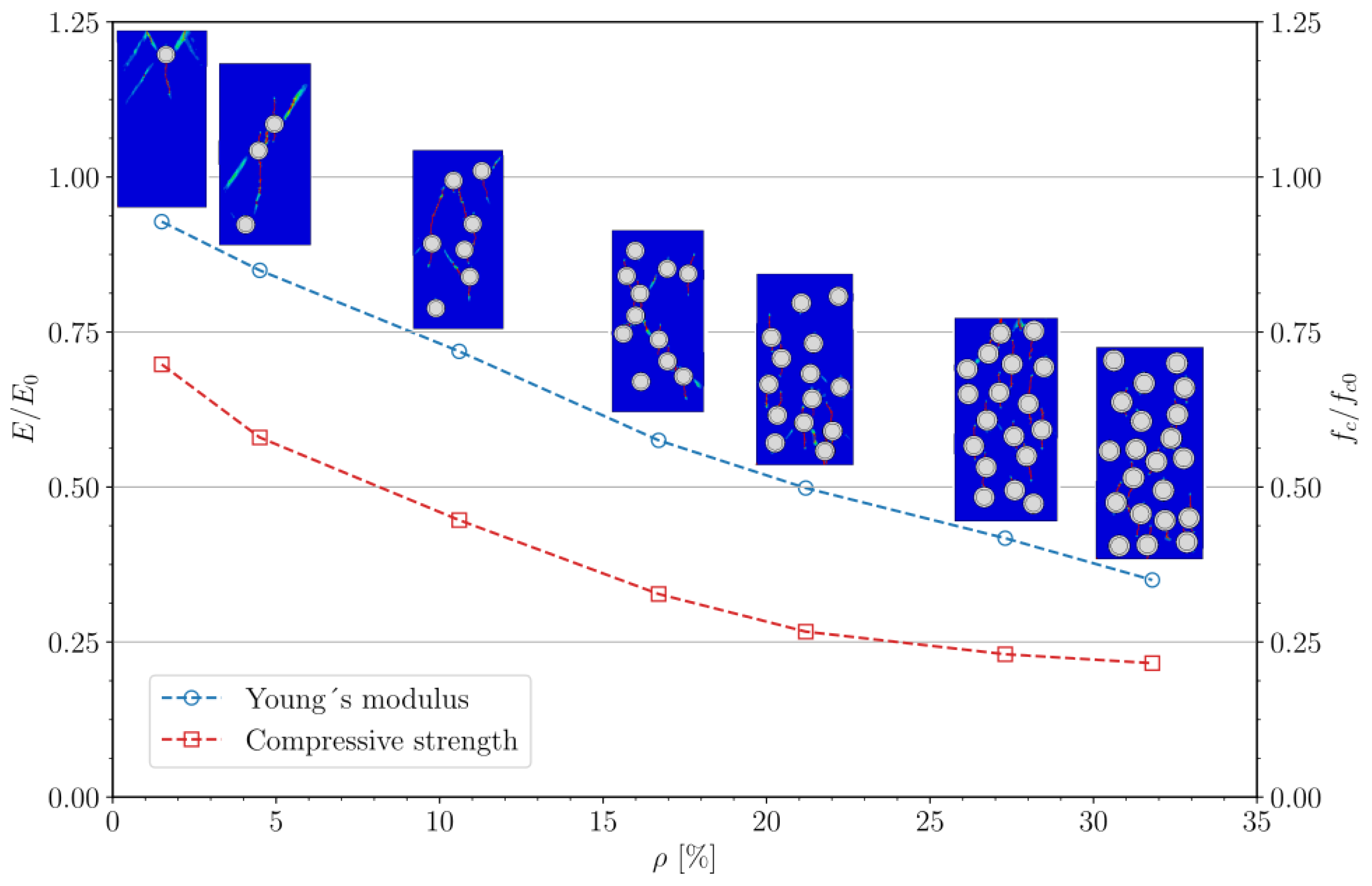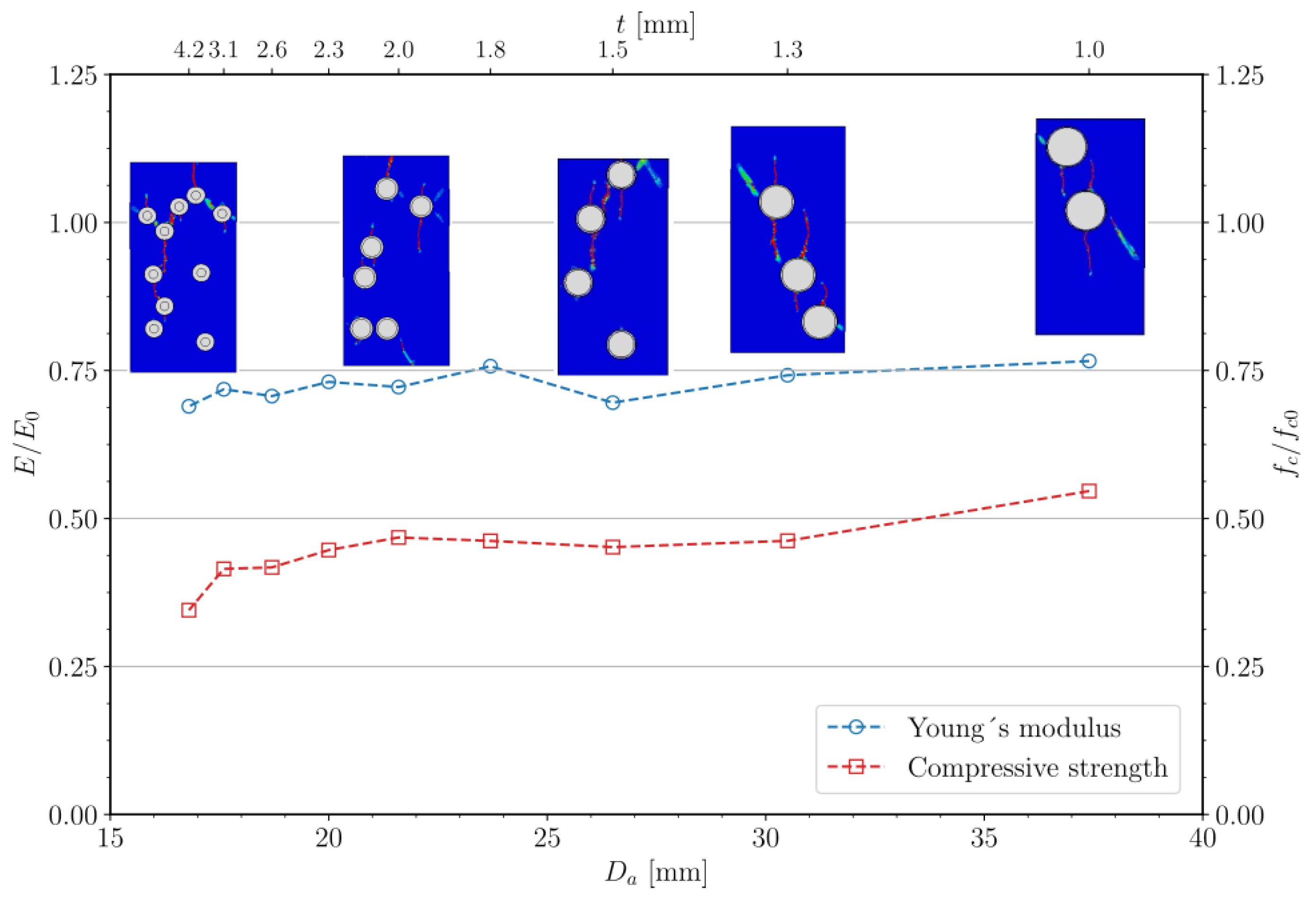1. Introduction
Artificially structured materials designed to exhibit properties not typically found in nature are metamaterials. Their conceptual foundation dates back to the late 1960s, when Veselago [
1] proposed the idea of materials with negative refractive indices, sparking broader research into the manipulation of waves. Initially explored for electromagnetic applications, metamaterials later demonstrated remarkable capabilities in acoustic domains, where engineered microstructures can selectively filter or redirect sound waves [
2,
3]. These systems can show negative effective mass or stiffness by exploiting local resonance phenomena, resulting in band gaps over specific frequency ranges [
4,
5]. Since then, numerous metamaterials have been developed, incorporating diverse mechanisms such as locally resonant structures, phononic crystals (PCs), and geometric-based resonators, each tailored to manipulate wave propagation in distinct ways [
6,
7,
8,
9,
10,
11,
12,
13,
14,
15,
16]. Capitalizing on these properties, civil engineering researchers have introduced metaconcrete, which integrates resonant inclusions into conventional matrices to mitigate dynamic loads such as impact, blast, and seismic excitations [
17,
18,
19,
20]. This innovative approach exploits the unique wave-filtering properties of metamaterials to enhance structural resilience under various transient or vibrational conditions.
Unlike standard concrete, MC incorporates inclusions similar to rubber-coated steel balls or metallic cores with compliant coatings that resonate locally under dynamic loads [
21,
22]. This resonance phenomenon effectively filters or attenuates stress waves that pass through the material, reducing transmitted wave amplitudes and associated damage [
23,
24,
25,
26]. Early studies showed that researchers could tailor the resonant behavior by adjusting the geometry, coating thickness, material properties, and volume fraction of the inclusions [
19,
27,
28]. Recent work on complex lattice-like inclusions has demonstrated that 3D resonator arrays can enhance vibration damping over a broader frequency range [
29,
30,
31]. There are various practical applications of metaconcretes in specific civil engineering problems, such as the dissipation of impulsive loads (e.g., explosions) [
32], their use in the design of new seismic protection systems [
33,
34], and vibration attenuation [
35].
Despite notable advances in dynamic performance, recent studies have highlighted potential compromises in mechanical response when incorporating resonators. In particular, soft coatings, which are vital for local resonance, weaken interfacial bonds and create stress concentrations that undermine the quasistatic load-bearing capacity [
36,
37,
38,
39,
40,
41]. Some investigations have reported compressive strength reductions of up to 50% when adding resonators at just 10% by volume in concrete samples, underscoring the need to consider these design trade-offs carefully [
36]. Such findings highlight the importance of comprehensively evaluating both dynamic and static requirements to optimize the performance of metaconcretes [
40,
42,
43].
The available experimental evidence suggests that adequately adjusting the resonator’s stiffness, the coating’s thickness, and the volume fraction can yield metaconcretes with compressive strengths comparable to those of conventional concretes [
40]. Achieving this balance requires a deep understanding of the underlying failure mechanisms.
A growing body of research has employed mesoscale numerical models to elucidate the mechanical response of metaconcretes. For instance, Xu et al. [
44] developed a finite-element model of metaconcrete bars subjected to impulsive loading and validated it experimentally. Mitchell et al. [
17] introduced the concept of metaconcrete by substituting conventional aggregates with specifically designed resonant inclusions, demonstrating a significant attenuation of shock waves and vibrations through Finite Element Method (FEM) simulations. Zhang et al. [
45] further explored this approach by numerically investigating dual-resonant aggregates in metaconcrete, revealing enhanced wave attenuation and tunable bandgap properties.
In parallel, studies employing the Discrete Element Method (DEM) have also contributed essential insights. Han and Lu [
46] investigated the forced vibration-damping characteristics of metaconcrete at the unit-cell scale, optimizing aggregate selection to enhance vibrational mitigation. Additionally, Han and Lu [
47] examined nonlinear vibration behaviors of single aggregate systems within metaconcretes, demonstrating how resonator design can significantly impact dynamic performance.
Notwithstanding these advances, existing numerical studies typically assume regularly arranged resonators, whereas practical castings are expected to exhibit a random spatial distribution of inclusions within the cementitious matrix. Furthermore, most investigations have primarily focused on predicting eigenfrequencies and associated band gaps as functions of resonator type and volume fraction, leaving the impact of resonator incorporation on the quasi-static compressive strength of metaconcretes largely unexplored. This study explicitly addresses this gap by investigating the mechanical response of metaconcrete under quasi-static loading conditions with randomly distributed resonators, thus establishing the novelty and relevance of the research approach.
To this end, the present study introduces a mesoscale numerical model (the first of its kind dedicated to capturing the mechanical behavior of metaconcretes) that explicitly accounts for heterogeneous material distributions and interfacial mechanics. Following validation of the model against experimental data sets from the literature [
36], the research team investigated the effects of varying resonator size, content, and distribution on static compressive performance. The study offers critical insights into these factors, laying the groundwork for the rational design of multifunctional metaconcretes that can mitigate dynamic hazards while maintaining a reasonable load-bearing capacity.
This paper aims to shed light on the proper empirical studies conducted using a mesoscale numerical model to simulate the compressive response of MCs, organized into the following seven main sections. The first section provides a brief explanation of the reason behind the approach. In the second section, the authors describe the research design using a description of the method. The third section details the validation of the specific model. The fourth section presents the main findings of the empirical approach. The fifth section explains how to analyze the results to gain further information on the research issue. The sixth section summarizes the conclusions based on the results. Finally, the seventh section deals with research limitations and future directions.
2. Description of the Numerical Model
A custom Python script constructs the FEM using Abaqus (2017 version), automating the entire process from geometry creation to meshing, material assignment, assembly, and load application.
The two-dimensional specimen has a height of 200 mm and a width of 100 mm. Consequently, the study randomly embedded circular resonators within this rectangular concrete matrix until the desired area fraction was reached. Each resonator comprises three regions: an internal steel core that provides high stiffness, a compliant annular rubber coating designed to introduce flexibility, and an interfacial transition zone (ITZ), which is explicitly modeled as a thin layer (0.1 mm) surrounding each resonator [
48]. The ITZ represents a weak bonding interface between the concrete and the resonator, which captures local effects such as stress concentrations and potential debonding phenomena. A random positioning algorithm prevents resonator overlaps, thus ensuring a minimum separation distance between each other and specimen boundaries. A recursive verification routine iteratively reassigns positions whenever an overlap occurs.
Figure 1 shows a schematic illustration of the resonator configuration.
Each model component is assigned specific material properties to represent its mechanical response accurately. These models are based on the concrete damaged plasticity (CDP) model, which is used to capture material fracture. This constitutive model can simulate nonlinear behavior and damage evolution under compressive loading by accounting for both tensile cracking and compressive crushing. The CDP model provides a realistic representation of failure mechanisms in concrete-like materials. The CDP model represents concrete and ITZ, while the rubber coating and steel core are expressed as linear elastic materials.
Instantiating the concrete sample with each resonator component—including the ITZ, rubber coating, and steel core—creates the assembly. The interaction between the different phases has been modeled with perfect adhesion using a tie contact approach, which allows for an accurate representation of the system when phases are in mutual contact [
49]. Adopting a tie contact enables the independent meshing of each phase, thereby avoiding the need for node matching at the interfaces and simplifying model generation, particularly when the inclusions are randomly distributed. Because the tie constraint interpolates displacements without permitting separation or sliding, the associated computational cost remains low for two-dimensional analyses.
For the loading scenario, a smooth displacement load is applied to the top edge of the concrete sample, while the bottom edge is fully fixed to simulate support. An explicit dynamics step, with automatically controlled time incrementation, is defined to capture the quasistatic compressive response, employing explicit integration throughout the simulation. According to the data summarized in
Table 1, the complete model generation has been automated via Abaqus’ Python scripting interface. This script sets key simulation parameters (e.g., material properties, boundary conditions, and load amplitudes), generates specimen geometry with randomly distributed inclusions, and performs meshing operations for each part. Moreover, CDP parameters are calibrated by comparing numerical predictions with experimental data [
36], ensuring that the simulated response accurately reflects the behavior of the observed material.
3. Validation of the Proposed Model
This section is devoted to validating the proposed model based on the experimental results reported in [
36]. Simple compression tests were conducted on cylindrical high-strength concrete specimens, each measuring 20 cm in height and 5 cm in diameter. Two configurations were considered: the first consisted of a plain concrete specimen, whereas the second involved a concrete specimen containing 10.6% resonators. These resonators comprise a spherical steel core with a diameter of 15.4 mm, covered by a 2.3 mm-thick layer of rubber.
The mechanical properties of the concrete were obtained from the work published by Xu et al. [
36]. According to that study, the concrete exhibits a Young’s modulus of 25.42 GPa, a Poisson’s ratio of 0.173, a density of 2183 kg/m
3, a compressive strength of 67.49 MPa, and a failure strain of 0.38%.
Regarding the characterization of the ITZ’s mechanical behavior, the same values used for the concrete were adopted, except for the strength, which was set to 50% of that of the concrete (33.75 MPa) [
48]. An ITZ thickness of 0.1 mm was also considered [
40,
50,
51,
52].
The properties of steel and rubber materials were assumed to behave linearly when modeling the resonators. A Young’s modulus of 210 GPa, a Poisson’s ratio of 0.3, and a 7800 kg/m
3 density were adopted for steel. A Young’s modulus of 50 MPa, a Poisson’s ratio of 0.5, and a 1300 kg/m
3 density were considered for the rubber. Four-node plane–stress elements with reduced integration (CPS4R) from the Abaqus/Explicit library were employed [
49].
Figure 2 shows the stress–strain curves obtained from compression tests on concrete specimens, including the three specimens tested in earlier experiments [
36], as well as the curve obtained from the implemented FEM. Consequently, the constitutive model parameters employed to delineate the concrete’s mechanical behavior exhibit high congruence with the experimental outcomes.
To quantitatively compare the numerical results with the experimental data,
Table 2 provides a comparison of the mean values and standard deviations of Young’s modulus (
), and the compressive strength (
). Young’s modulus was calculated from the stress–strain curves through the following expression [
53]:
where
corresponds to the stress at a strain of 0.005%, and
and
are the stress and strain at 40% of the failure stress. The results in
Table 2 indicate that the CDP model, utilizing the established concrete parameters, exhibits a high degree of compatibility with the experimental data. Thus, the proposed model exhibits strong alignment with Young’s modulus and the strength parameters, with deviations of less than 4%.
Three FEMs, each showing a distinct distribution of resonators within the concrete matrix, were created for the specimen with resonant inclusions. Following the execution of a mesh-size sensitivity study, an element size of 1.0 mm was selected. To perform a mesh size sensitivity analysis, element sizes of 0.5, 1.0, 2.0, 3.0, 4.0, and 5.0 mm were considered. As shown in
Figure 3, the mesh-size sensitivity analysis was based on Young’s modulus, compressive strength, and the cracking pattern (inferred from the tensile damage variable). In the CDP model, the degradation of tensile strength is tracked through a scalar variable representing tensile damage. The value of the scalar tensile-damage variable is equal to 0 when the material is undamaged (see blue elements in the figure). Conversely, a value close to 1 indicates complete tensile failure (see red elements in the figure). Consequently, mapping the spatial distribution of the scalar tensile-damage variable offers an indirect representation of cracks. Refinement of the mesh reveals that the predominant crack trajectories align vertically, in agreement with the experimental results cited above [
36]. All three parameters converge reasonably well from a mesh size of 1.0 mm onward.
As shown in
Figure 4, stress–strain curves have been obtained from these three configurations using the proposed model and compared to the three experimental curves reported in [
36]. In addition, the figure presents the cracking patterns obtained for each analyzed case. The numerical results show good agreement with the experimental data.
Table 3 shows the mean values and standard deviations (SD) of Young’s modulus and compressive strength for concrete specimens containing 10.6% resonators. Based on a comparison between experimental data obtained from the study and those collected from FEM results, the investigation showed that the predicted Young’s modulus exhibits an error of about 20%. In contrast, the compressive strength error remains below 1%. Acknowledging the substantial discrepancy observed in the prediction of Young’s modulus is imperative. However, the lack of information on rubber characteristics in Xu et al.’s experiments explains this difference [
36]. Consequently, generic values for the rubber’s Young’s modulus were used to estimate the material properties.
These findings suggest that the proposed model accurately captures the mechanical behavior of metaconcretes, particularly in predicting Young’s modulus and key strength parameters, including compressive strength and failure strain.
5. Discussion
The results presented in the previous section reveal several vital insights regarding the influence of resonator characteristics on the mechanical properties of MCs.
First, the analysis of the resonator ratio shows a clear trend: both Young’s modulus and compressive strength decrease with increasing resonator ratio. Notably, the compressive strength experiences a pronounced reduction, exceeding 25% with the inclusion of just one resonator, before approaching an asymptotic value that is approximately 20% lower than that of the plain concrete. The observed asymptotic behavior can be attributed to localized weakening around the inclusion. Once enough resonators are included, further increments in damage and crack initiation produce limited additional global weakening, as these phenomena dominate the overall response. This behavior is consistent with a mixing law [
54,
55], where the addition of a secondary phase (in this case, resonators) progressively diminishes the effective load-bearing area. The low dispersion in the measured values (SDs below 3%) confirms that the spatial distribution of resonators has a relatively minor effect on these macroscopic properties.
Second, it has investigated the effect of resonator dimensions, specifically the resonator diameter, as well as the relation between the core size and the coating thickness on the mechanical response of the MC. The data indicate that variations in Young’s modulus remain within 10%, while compressive strength varies by approximately 15–20% as the resonator size decreases. The corresponding cracking patterns corroborate these findings, showing that cracks initiate at the resonators and follow predominantly vertical paths. As the number of resonators increases, the connectivity of cracks increases, thereby reducing the overall compressive strength.
Finally, the study of material properties—examining both the elastomer coating and the core material—demonstrates that modifications in the coating’s Young’s modulus produce modest changes in the overall mechanical response. Although the compressive strength varies by about 6% across the range of elastomer moduli tested, Young’s modulus primarily remains insensitive to these changes. Furthermore, substituting the steel core with a lead core has a minimal impact on the mechanical properties of the resonator dimensions considered, suggesting that the macroscopic behavior of the composite is governed more by the resonator geometry and distribution than by the specific material properties of the core.
Additionally, the low dispersion in almost all the results is noteworthy, indicating that the spatial distribution of the resonators has a relatively minor, yet slightly more pronounced, influence on the compressive strength compared to Young’s modulus. This is relevant, as it suggests that slight variations in spatial distribution during fabrication are unlikely to result in substantial changes to mechanical properties.
Overall, these findings suggest that the optimal design of MCs involves using larger resonators with thinner rubber coatings and a lower resonator ratio, thereby ensuring a balance between enhanced dynamic behavior and acceptable mechanical strength. The consistency of these trends with experimental observations reported in the literature [
36] further validates the proposed numerical model.
The following equation is proposed as a function of the compressive strength of the concrete without resonators and the volumetric content of the resonators based on the results of the simulations conducted in this work. This equation approximates the compressive strength of the MC:
where
is the compressive strength of the concrete without resonators, and
γ is a constant obtained via a least-squares fit. In our analysis,
was determined to be 0.114, with a coefficient of determination,
= 0.826.
Figure 9 presents the fitted function alongside the numerical results. While increasing the resonator content broadens the low-frequency band gap and enhances wave attenuation, it simultaneously diminishes the quasi-static load-bearing capacity. The present results indicate that limiting the resonator volume ratio to
3–5% preserves at least 55% of the reference compressive strength—an acceptable threshold for lightly loaded vibration-control elements, such as isolation slabs or track beds. This strength window will serve as the basis for future work, wherein the current mesoscale framework will be coupled with transient wave-propagation simulations to quantify how the observed reduction in
affects attenuation, bandwidth, and efficiency.
The simulation results suggest the potential for a novel function that estimates Young’s modulus from the compressive strength of MC. Given the dispersion of the data in both the lower and upper ranges of compressive strength, one flexible approach is to assume that
behaves as a power function of
, following the format of Eurocode 2 [
58]. In other words, the aim is to identify the constants
and
as follows:
Through a least-squares fitting procedure, constants are appropriately determined to obtain
1.3123 and
= 0.7646. This fit yields a coefficient of determination
0.9358. Consequently,
Figure 10 displays the simulation results alongside Equation (4).
While these relationships offer a valuable preliminary framework for structural design, their validity is constrained to the parameter ranges that have been investigated. Further experimental validations would be instrumental in extending the scope and reliability of these relationships.
6. Conclusions and Future Directions
A two-dimensional mesoscale model has been developed to reproduce uniaxial-compression tests on metaconcretes, explicitly representing steel cores, rubber coatings, and the interfacial transition zone. Numerical predictions agree well with the experiments, capturing both stiffness and strength reductions. The parametric study quantifies these reductions: inserting a single resonator ( ≈ 1.5%) already lowers the reference compressive strength by 30%, while the highest ratio examined ( = 31.8%) produces an 80% loss, which defines the asymptotic plateau of the strength curve. Keeping the resonator content below 5% preserves at least 55% of the baseline strength and more than 85% of the plain-concrete Young’s modulus. At an intermediate ratio (ρ = 10.6%), large-core inclusions ( ≥ 30 mm) with thin rubber coatings ( ≤ 1.3 mm) restrict the stiffness penalty to <10% and the strength reduction to 15–20%. Overall, an optimal practical window of 3–5%, combined with large-diameter, thin-coated resonators, achieves the desired locally resonant behavior while limiting the compressive-strength penalty to ≲45%.
Based on the findings of this study, future research should focus on the following points regarding such a new engineered material:
Extending to 3D simulations through three-dimensional modeling to capture out-of-plane effects, triaxial stress states, and more realistic resonator placements;
Refining coating material characterization so as to incorporate nonlinear or viscoelastic constitutive models for elastomers that could improve predictive accuracy, particularly under long-term or dynamic loading;
Examining alternative resonator designs to investigate lattice-like inclusions, composites, or other geometries that may help broaden the feasible design space;
Integrating dynamic and fatigue analyses of metaconcrete to attenuate vibrations and shocks and evaluate fatigue and impact responses would yield a complete performance assessment;
Validating at-large scales from testing on metaconcrete would confirm mesoscale findings and guide further design recommendations;
Extending the mesoscale framework to metaconcrete columns subjected to lateral confinement to quantify its influence on compressive strength and ductility, drawing on experimental insights;
Investigating the interaction of recycled crumb-rubber particles and chemically treated rubber coatings with OPC and alkali-activated slag binders, assessing their impact on compressive strength, durability, and interfacial chemistry, and developing mitigation strategies for the associated strength loss.
Addressing the research gaps above will improve confidence in specific metaconcrete technologies and facilitate their transition into broader engineering practice.

















